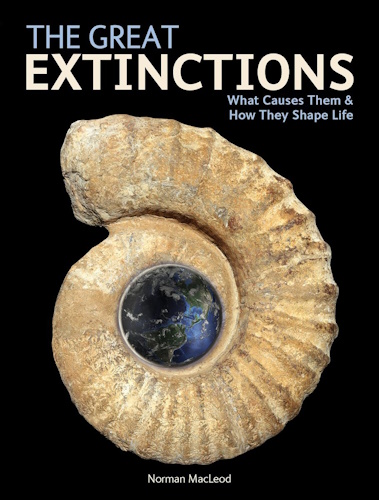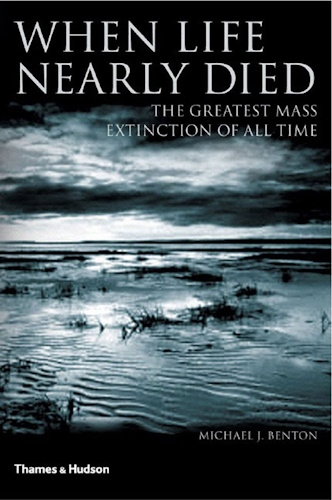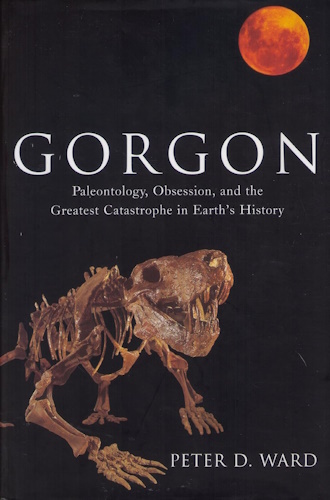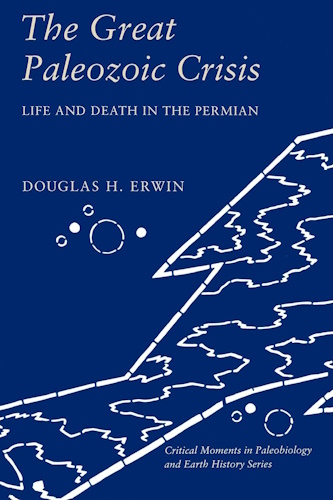![]()
The Case
of the
Permian Extinction
Retrieved from archive.org
by Gail Bird Allen
March 16, 2018
![]()
The Case
of the
Permian Extinction
Introduction:
At the end of the Permian period, the world was becoming increasingly warm (Newell 1953). Along with this rise in temperature, much of the ocean's water evaporated, causing a drop in sea level of up to 200 meters (Gall 1998). In addition, the continents converged to form the super-continent Pangea and super-ocean Panthalassa. By examining the structure and number of stomata on fossilized plants, scientists have concluded that Carbon Dioxide levels were much Higher and atmospheric Oxygen levels were much lower than those of today (Gall1998).
The Permo-triassic Boundary (PTB) featured the largest extinction the world has ever experienced. Although Mass extinctions have occurred in the past, this particular occurrence is remarkable in that it took place in a relatively short period of time. Scientists estimate that approximately 85% of all marine species (predominately invertebrates) and 70% of all terrestrial species went extinct in less than one million years (Bowring 1998). Braciopods by far suffered the largest casualties, but other victims include Acritarchs, Archaeocyathids, Molluscs, Echinoderms, Gusulinid Foraminifera, Corals, Diatoms, Dinoflagellates, Stromatoporoids, and Trilobites (Hooper Virtual Palaentological Museum 1999). So great was this die-out that fungal species were temporarily the dominant form of terrestrial life (Monastersky 1996). Causes of this catastrophe are yet unknown, but several theories have been suggested. This project, created by Audrey Johnson and Doug Blevins, seeks to present and examine these ideas.
Theories of Causes:
Many theories have been presented for the cause of the Permian - Triassic Extinction. These include volcanism, plate tectonics, anoxia of oceans, super nova explosions, severe weather, changes in sea level and atmospheric gas levels, climate change, and collision with a meteorite or comet. Here are these ides in more detail:
Collision of a Meteorite of Comet and Severe Weather patterns:

If a meteorite or comet struck the earth, its aftermath would either weaken or kill much of the life that thrived during this time. Release of debris and CO2 into the atmosphere would reduce the productivity of life and cause both global warming and ozone depletion. Indeed, evidence of increased levels of atmospheric levels of CO2 exist in the fossil record. A bolide impact from an icy, carbon-rich comet could produce such a change. Volcanic activity, on the other hand, could also produce the same effects. Material from the Earth's mantle (released during volcanic eruption) has also been shown to contain Iridium, an element commonly found in meteorites(BBC 1999). Other than changes in atmospheric carbon, no evidence exists for this theory. This does not, however, rule it impossible (Bowring 1998).
It has also been proposed that such a collision would heat up ocean waters enough to produce "hypercanes". These violent storms feature high winds (near the speed of sound) and enormous vortecies. Conditions of this strength would be capable of demolishing forests and other ecosystems (Lomb, 1999). Although not impossible, this theory has little supporting evidence. **Image courtesy of Star Dust**
Supernova Explosion:

University of Chicago astrophysicist David Schramm has proposed a theory of a supernova causing ozone depletion. A super nova occurring 30 light years away from earth would release enough gamma radiation to destroy the ozone layer for several years. Subsequent exposure to direct, undiluted ultra-violet radiation would weaken or kill nearly all existing species. Only those living deeper in the ocean would be spared. Statistical frequency of Supernovae suggests that one could have easily occurred at the PT Boundry. Sediments contain records of short-term ozone destruction (large amounts of NOx gasses and C14 plus "global and atmospheric cooling" ) (Ross 1995). Present day observations of ozone depletion demonstrate the harmful effects of UV radiation on life. Genetic damage and cancers rank amoung the most prevalent effects. With sufficient destruction of the ozone layer, these problems could culminate in widespread destruction of life.
As a relatively new suggestion, this theory does not have much evidence either for or against it. It is a possibility, but more information is needed to determine its probablility. ** Graphic from Global Change class website**
Sea -level changes and Contental Drift:
Around the time of the Permian Extinction, the continents joined to form the super-continent Pangea and the super-ocean Panthalassa. This would radically decrease the range of shallow aquatic environments and put unnecessary stress on others. Several marine ecosystems would not be able to survive such drastic changes; their members would subsequently perish (Wingall 1996). Decrease in sea level is brought about by evaporation, glaciation, or shifts in topograhpy (Gall 1998). Warm, shallow aquatic ecosystems are very susceptible to even the slightest changes in sea level (BBC 1999). As with the formation of Pangea, few organisms could have thrived in a drasticaly changing envirnonment.
In addition to decreasing sea levels, the formation of a super continent would undoubtedly disrupt oceanic circulation. The waters would stagnate (causing a decrease in the flow of nutrients) and weather patterns would be adversely affected. Both of these changes would disrupt or destroy shallow, marine habitats .
The destruction of terrestrial life and the sudden nature of this event weaken both of these arguments. Since both aquatic and land-dwelling organisms suffered similar destruction rates (Kozur 1998), the Permian extinction must have a global cause. Also, very gradual changes, such as continental drift, could not have cause such a rapid decrease in biodiversity (Bowring 1998). These may have contributed to the overall effect, but certainly were not the sole explanation.
Volcanic activity:
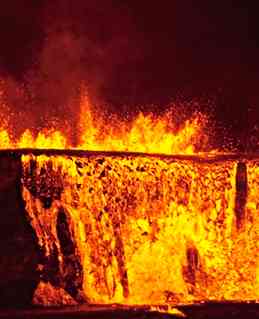
The Permian - Triassic Boundry was marked with many volcanic eruptions, which can be described by plume tectonics. Plume tectonics is a theory which involves sending a heat pulse, produced by reactions between the Earth's core and mantle, toward its surface. This heat pulse melts the crust and eruptions of thousands of cubic kilometers of basaltic lava result. This eruption of the Siberian Traps, a range in Northern Eurasia, which spewed tons of CO2 and Sulfur gasses into the atmosphere, is the largest known eruption in the history of our planet (Cowen 1999). This eruption produced acid rain that could have severely weakend life. If growth were sufficiently retarded, other stressful events could have resulted in extinction (Bowring 1998). As with the comet theory, layers of Iridium, which are also produced by volcanic eruptions, exist as evidence of this hypothesis. This idea, however, has more geologic support than that of the comet. **Graphic courtesy of Dick Rasp**
Concentration of CO2 and Anoxia:
Because volcanic activiy affects the concentration of atmospheric gasses, it indirectely effects the concentration of oceanic dissolved gasses. Increases in carbon dioxide concentration aid the green house effect, and cause global warming. Scientists believe that this warming lessened the temperature gradient between the equator and the poles. As a result, thermo-haline circulation would slow and eventually stop (Wingnall 1996). The oceans would stagnate, and nutrients would fail to disperse themselves. Many marine ecosystems rely on upwelling and circulation of nutrients, oxygen included. Without the regular circulation, organisms would starve and/or suffocate (Monastersky 1996).
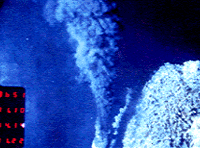
In addition, Sulfur and particulates contribute to cooling, or volcanic winter, which usually lasts three to six months (Kozur 1998). Combinations of the two could produce a warming-cooling cycle, in which the climate alternatively warms then cools. Fluctuations in temperature, which are evident in the fossil record, could cause connective overturn of the oceans (Bowring 1998). This would have a series of detrimental effects on marine and indirectely on terrestrial life. Connective overturn, or the sudden inversion of surface and deep water due to differences in temperature, would bring more CO2-rich, anoxic bottom waters to the surface (Wingnall 1996). In an already oxygen deprived envirnoment, this is a death sentence. According to Urainium/Thorium Ratios of late Permian sediments, the oceans were severely anoxic around the time of the extinction (Bowring 1998). This theory is by no means proven, but a wealth of evidence supports it. **Graphic courtesy of Scott Veirs**
Conclusion:
The truth probaly includes several of these hypotheses. Never before and never since has the earth seen such widespread extinction. As Michael Lomb said on the first page of his 1999 essay, "The Permain Extinction, Earth's Greatest Catastrophe", "It's not easy to destroy most of life on Earth." Whatever caused this extinction was a mighty force. It's unlikely that any of these thoeries alone caused the Permian Extinction. Undoubtedly, many factors contributed to the die - off of so many of earth's spieces. In all probablility, volcanic activity and climate - induced changes in the oceans added to the severity of the event. Perhaps contental drift and slower global cycles laid the groundwork for this catastrophe. As of today, nobody knows the precise cause of the Permian Extinction, but the "Murder on the Orient Express" theory, proposed by Douglas Erwin in 1993, is most likely correct. It states that everything in the earth is inter -related, and as such, many factors influence each other. Changes as drastic as the Permian extinction are the product of many forces, which together cause widespread disruption. Research still continues on this topic, and our knowledge is expanding. Perhaps future discoveries will reveal the answer.
Summary of Extinction Events:
The Permian Period, which directely proceeded the Triassic, lasted from approximately 286 million years ago (mya) to 248 mya (Gall 1998). Analyzation of Uranium and Lead deposits in sediments of this time has placed the Permian - Triassic Boundry (PTB) at 250 to 251mya. This period ended with the mass extinction of the majority of life on the planet. Originally, scientists believed this was a gradual die-off, which took place over several million years. Now, due to geochronology, it was proven to have lasted less than one million years (from 252.3mya to 251.4mya +/- 300 000 years) (Bowring 1998). In such a short period of time (geologically speaking), about 85% of all marine species and 70% of all terrestrial species went extinct (Kozur, 1998). This catastrophe affected all regions equally. In opposition to popular belief, all organisms, regardless of habitat, suffered similar rates of extinction (Curran 1997). Such equality suggests that the cause of the event was a global, not local, occurrence.
Although several theories have been suggested, some are more accurate than others. We do not know the true cause of this extinction, but we can rule out some of these ideas. Because the extinction only lasted for approximately one million years and affected both terrestrial and marine habitats equally, gradual changes, as well as purely marine explanations, are unlikely answers to the problem. They may have contributed to the overall effect, but they cannot be the sole source of the crisis (Bowring 1998). Because of the sheer magnitude of this extinction event, many different factors probably contributed to its occurrence. **Graphic from Global Change class website**

Sources:
Bartlett, Kristina. December 1998. Closing on Extinction Rates. Geotimes. Vol 43, Issue 12: 7.
BBC, "Theories of Mass Extinction: Climate Change Theory". Unknown. <www.bbc.co.uk/education/darwin/exfiles/sealevel.htm> (29 November 1999).
BBC, "Theories of Mass Extinction: Sea Level Theory". Unknown. <www.bbc.co.uk/education/darwin/exfiles/volcano.htm> (29 November 1999).
Bowring, S.A., Erwin, d.H., Jin, Y.G., Martin, M.W., Davidek, K., and Wang, W., U/Pb Zircon Geochronology and Tempo of the End-Permian Mass Extinction. may 15, 1998. Science. Vol280: 1035 - 1045.
Cowen, Richard. "The Permo-Triassic Extinction". 1999 . <www-geology.ucdavis.edu:8000/~GEL107/Permian.html> (5 December 1999).
Curran, Chris. "An Equal Oppurtunity Extinction? Cincinnati Geologists Find Global Impact of Permian Die-off". 1997. <www.uc.edu/info-services/permian.html> (29 Nov 1999).
Frakes, L.A., Francis, J.E., and Syktus, J.I. 1992. Climate Modes of the Phanerzoic. Cambridge University Press, New York.
Gall, J.C., Grauvogel-Stamm, L. Nel, A., Papier, F. January 1998. Permian mass Extinction and Triassic Recovery. Comptes Rendus De L Academie Des Sciences Serie II Fascicule A-Sciences De Lo Terre Et Des Planetes. Vol326:1-12.
Grimm, K.A., Simpson, K., and Lambertson, M.N., "The Permian Reef Complex (Delaware Basin) of Texas" Undated <www.science.ubc.ca/~eoswr/slidesets/guad/slidefiles/> (4 Dec. 1999).
Hooper Virtual Palaeontological Museum. "Speculated Causes of the Permian Extinction" 1996. <park.org/Canada/Museum/extinction/permcause.html> (29 November 1999).
Kozur, H.W., November 1998. Some Aspects of the Permian-Triassic Boundry (PTB) and Possible Causes For the Biotic Crisis Around This Boundry. Palaeogeography Palaeoclimatology Palaeoecology. Vol 143: 227-272.
Lomb, Michael. "The Permian Extinction, Earth's Greatest Catastrophe" 16 March 1999. <www.geocites.com/CapeCanaveral/Hanger/5408/permian_extinction.htm>(5 December1999).
Monastersky, R., 26 May 1998. Death Swept Earth at End of Permian. Science News. Vol 153, Issue 20: 308-309.
Monastersky, R., 16 March 1996. Fungi Stand Alone. Science News. Vol 149, No 11: 164.
Monastersky, Richard, 25 May 1996. Oxygen Starvation Decimated Permian Oceans. Science News. Vol 149, Issue 21: 326 - 327.
Newell, Norman D., Rigby, J. Keith, Fischer, Alfred G., Whiteman, A. J., Hickox, John E., Bradley, John S., 1953. The Permian Reef Complex of the Guadalupe Mountains Region, Texas and New Mexico. W. H. Freeman & Company, San Fransico, California.
Rampino, Michael R., May 1998. Evidence for abrupt Latest Permian Mass Extinction of Foraminifera: Results of test for the Signor -Lipps Effect. Geology. Vol 26, Issue 5: 415.
Rasp, Dick, "Hawaii Volcanoes-National Park" 5 Nov 1999 <http://www.nps.gov/havo/> (5 Dec 1999).
Ross Ph. D., Hugh, "Permian Extinction Update". 1995. <reasons.org/resources/FAF/95q1faf/95q1perm.html> (5 Dec 1999).
Seaborg, "The Permian" Undated <seaborg.nmu.edu/earth/Permian.html> (4 Dec. 1999).
Scotese, C. R., "At the end of the Permian was the Greatest Extinction of all times." 1997 <www.scotese.com/newpage5.htm> (29 Nov 1999).
Star Dust, "Star Dust". 1999 <exn.ca/StarDust/> (5 Dec 1999).
Trott, Shane Mass Extinction Debate - Carbon Dioxide Responsible for Permian Mass Extinction? New York Times. 1996 July 30.
Veirs, Scott, "Explore Aquarium" 8 Aug 1999 <www.ocean.washington.edu/people/grads/scottv/exploraquarium/> (5 Dec. 1999).
Wignall, Paul B., April 1999. Evidence for Abrupt Latest permian mass Extinction of Forminifera: Results of test for fhe Signor-Lipps Effect. Geology. Vol 27, Issue 4: 383.
Wignall, Paul, and Twitchett, Richard J., 24 May 1996. Science. Ocean Anoxia and the End Permian Mass Extinction. Vol 272:1155-1158.
![]()
![]()
Disclaimer:
Some material presented will contain links, quotes, ideologies, etc., the contents of which should be understood to first, in their whole, reflect the views or opinions of their editors, and second, are used in my personal research as "fair use" sources only, and not espousement one way or the other. Researching for 'truth' leads one all over the place...a piece here, a piece there. As a researcher, I hunt, gather and disassemble resources, trying to put all the pieces into a coherent and logical whole. I encourage you to do the same. And please remember, these pages are only my effort to collect all the pieces I can find and see if they properly fit into the 'reality aggregate'.
Personal Position:
I've come to realize that 'truth' boils down to what we 'believe' the facts we've gathered point to. We only 'know' what we've 'experienced' firsthand. Everything else - what we read, what we watch, what we hear - is what someone else's gathered facts point to and 'they' 'believe' is 'truth', so that 'truth' seems to change in direct proportion to newly gathered facts divided by applied plausibility. Though I believe there is 'truth', until someone representing the celestial realm visibly appears and presents the heavenly records of Facts And Lies In The Order They Happened, I can't know for sure exactly what "the whole truth' on any given subject is, and what applies to me applies to everyone. Until then I'll continue to ask, "what does The Urantia Book say on the subject?"
~Gail Bird Allen
![]()
![]()

